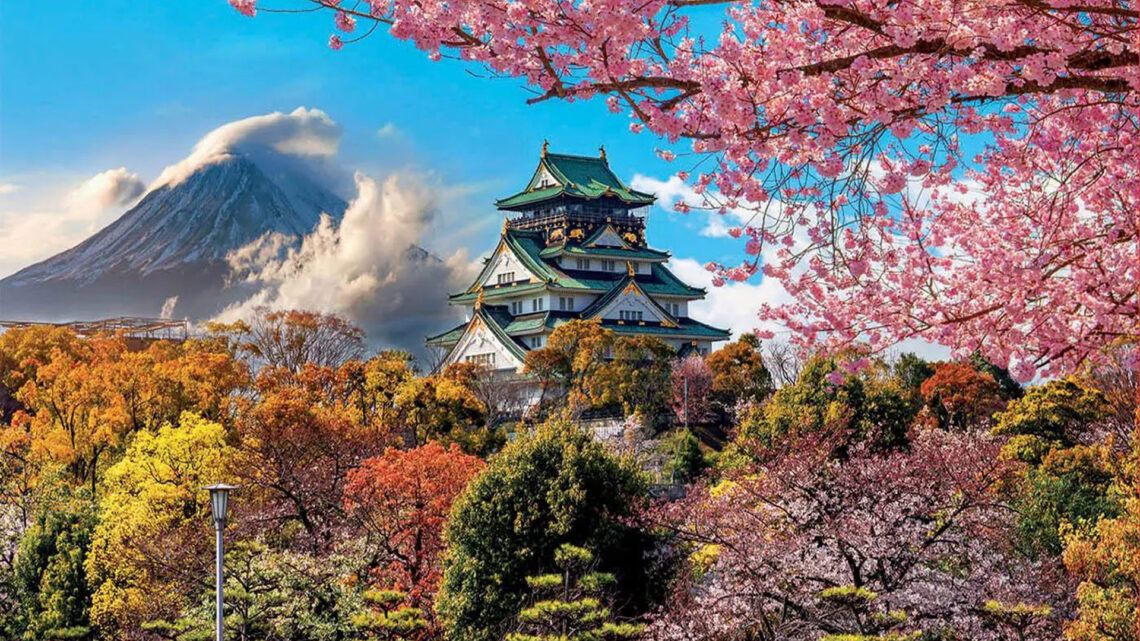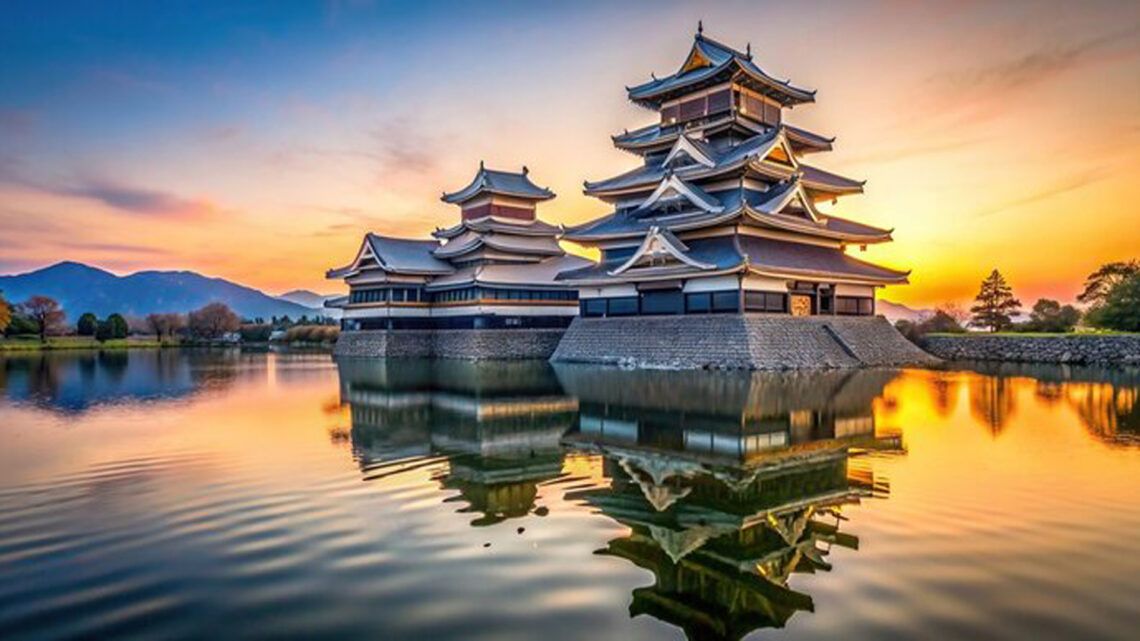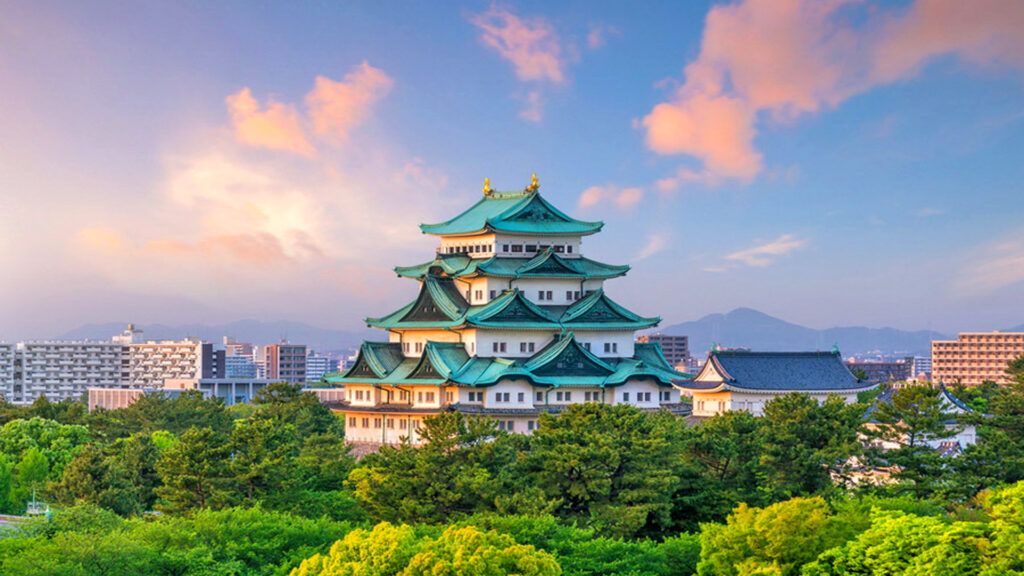
Nagoya Castle (Nagoya-jo) stands as a powerful symbol of Japan’s history, culture, and tradition, with significant architectural and historical value. Built in the early 17th century, the castle has played a central role in Japan’s history and remains an important cultural heritage site. Over centuries, it has endured multiple destructions and reconstructions, adding depth to its historical and cultural significance. This article will delve into the history and importance of Nagoya Castle, exploring its origins, architectural features, its place in Japanese history, and the extensive restoration efforts aimed at returning the castle to its former glory.
Nagoya Castle was constructed during the Edo period under the rule of the Tokugawa Shogunate. Tokugawa Ieyasu, the founder of the Tokugawa Shogunate, ordered its construction in 1610 to secure political and military control over the strategically vital Chubu region. Nagoya was chosen for its strategic location between Kyoto and Edo (modern-day Tokyo), making it an ideal point for controlling the country. The construction of the castle was completed within a few years, and it quickly became a center of political and cultural life.
The original castle was built using advanced techniques and materials of the time, featuring a massive stone foundation and intricate wooden structures. Surrounded by moats and stone walls, its architecture showcased the craftsmanship of Japanese builders of that era. One of Nagoya Castle’s most striking features is the pair of golden shachihoko, fish-like creatures perched on the roof, symbolizing protection and prosperity.
Nagoya Castle’s architecture combines traditional Japanese elements with a monumental scale and fortress-like sturdiness. The complex consists of an inner and outer castle, with the main keep (Tenshu) noted for its impressive multi-storied structure and central watchtower, which provided an excellent view of the surrounding areas.
A notable feature of the castle is its “shachihoko,” golden figures in the form of fish-like creatures found on the rooftops. These ornaments symbolize prosperity and protection against fire. Over the years, the shachihoko have become an unofficial symbol of Nagoya Castle, reflecting the attention to detail and artistic expression of that time.
Another significant aspect of Nagoya Castle was the Hommaru Palace, which served as the residence of the lord. The palace was famous for its elaborately decorated walls, gilded sliding doors, and intricate paintings. Artists and craftsmen from across the region contributed to its construction, bringing a high level of creativity and technical skill.

Nagoya Castle experienced several phases of destruction and reconstruction. During World War II, the castle was heavily damaged by air raids in 1945, with much of its historical structures destroyed. The main keep and the Hommaru Palace were lost to flames, a painful cultural and national loss for Japan.
In the 1950s, the Japanese government decided to reconstruct Nagoya Castle as a symbol of national restoration. The main keep was rebuilt in 1959 with a steel-reinforced concrete structure to meet modern standards of stability and safety, ensuring better protection against earthquakes and other natural disasters.
The reconstruction of the Hommaru Palace began in the early 2000s, meticulously preserving the historical details and authenticity of the original architecture. Room by room, the palace was rebuilt using traditional materials and techniques to honor the castle’s heritage. The palace restoration was completed in 2018 and has since become a popular destination for visitors from around the world, providing an authentic glimpse into historical Japan.
For centuries, Nagoya Castle has served as a symbol of Japan’s power, prosperity, and cultural flowering. It was not only a military stronghold but also a cultural center where arts, literature, and music thrived. The lords who resided in the castle fostered the arts, transforming Nagoya into a vital cultural center of Japan.
Today, Nagoya Castle is regarded as a symbol of cultural identity and historical heritage. The ongoing restoration work reflects Japan’s deep respect for its history and cultural legacy. The castle is a central feature of Nagoya’s cityscape, attracting millions of visitors each year who come to experience the beauty and historical significance of this remarkable structure.
Nagoya Castle is now one of Japan’s most visited historical sites and a popular destination for both tourists and locals. Beyond its impressive architecture and historical importance, the castle offers many opportunities for visitors to learn more about Japanese culture. Guided tours of the castle and palace provide deep insights into the history and lifestyle of the time.
The castle grounds also feature beautifully landscaped gardens, particularly popular during cherry blossom season (Hanami). Each year, numerous visitors come to view the castle against the backdrop of cherry blossoms in full bloom. The castle museum also hosts a variety of exhibitions showcasing historical artifacts and artworks, taking visitors on a journey back in time to historic Japan.
Today, Nagoya Castle functions as a living museum where the past and present uniquely converge. The continued restoration projects and efforts to preserve the castle in its original splendor are a testament to Japan’s respect for its history and culture. For visitors from around the world, the castle offers an unmatched glimpse into Japan’s history and aesthetics, standing as a prominent symbol of Japanese identity.
Activities Around Nagoya Castle

There are numerous activities and attractions around Nagoya Castle that enhance the visit. Here are some highlights:
Visit to Meijo Park
Located right next to the castle is Meijo Park, a beautiful public park ideal for walking and relaxation. Especially during cherry blossom season (Hanami), the park becomes a popular spot to admire the blooming cherry trees. With its picturesque paths, water features, and flower beds, Meijo Park is a year-round oasis of tranquility.
Nagoya City Science Museum
Just a few minutes from the castle is the Nagoya City Science Museum, which boasts the largest planetarium in the world, attracting visitors of all ages. The exhibits include interactive scientific experiences that clearly explain topics such as space exploration, biology, and physics. The museum is perfect for families and also provides exciting insights into the world of science for adults.
Shopping and Dining in Sakae
The lively Sakae district is known for its shopping malls, boutiques, and restaurants. Visitors can purchase traditional Japanese souvenirs, explore local fashion, or taste Nagoya specialties in the many restaurants. Local dishes like “Miso Katsu” (fried pork cutlets with miso sauce) and “Hitsumabushi” (grilled eel on rice) offer a glimpse into Nagoya’s culinary diversity.
Atsuta Shrine
The Atsuta Shrine is one of Japan’s most important Shinto shrines and is just a short train ride from the castle. It houses one of Japan’s three legendary imperial regalia, the sacred sword Kusanagi-no-Tsurugi. The shrine is a place of spiritual peace, and many visitors come to enjoy the atmospheric grounds with centuries-old trees and the tranquil surroundings.
Toyota Commemorative Museum of Industry and Technology
Since Toyota was founded in Nagoya, a visit to the Toyota Commemorative Museum is particularly interesting. The museum showcases the development of Toyota from a textile machinery factory to one of the world’s largest automobile manufacturers. In addition to historical machines and vehicles, there are interactive exhibits and demonstrations that highlight Japan’s innovation.
Nagoya TV Tower and Hisaya Odori Park
The Nagoya TV Tower offers an observation deck with stunning views of the city and the castle. The adjacent Hisaya Odori Park is a long, green strip of parkland in the heart of the city, perfect for walks and regularly hosting events and festivals like the Nagoya Matsuri (Nagoya Festival). Particularly in the evening, the park is illuminated with colorful lights, creating a romantic atmosphere.
Touri Shrine
The Touri Shrine, located near Nagoya Castle, is a peaceful, traditional Shinto shrine that is often less crowded, making it ideal for a relaxing stop. Visitors can enjoy the sacred atmosphere, woven with the history and culture of the place, and admire the iconic red Torii gates.
Noritake Garden
Noritake Garden is located on the former production site of the famous Noritake porcelain manufacturer and offers an insight into the history and making of high-quality Noritake porcelain. Visitors can witness the porcelain production process, visit the museum, and dine at the café inspired by traditional hand-painted porcelain pieces. Fine Japanese porcelain can also be purchased as a souvenir here.
The area around Nagoya Castle offers a wide range of activities and attractions that include historical, cultural, and modern experiences. From traditional shrines and museums to shopping streets and observation points, there is something for everyone. A visit to Nagoya not only allows you to admire the castle but also offers an opportunity to explore the region’s culture, cuisine, and history in diverse ways.
Culinary Specialties in and Around Nagoya
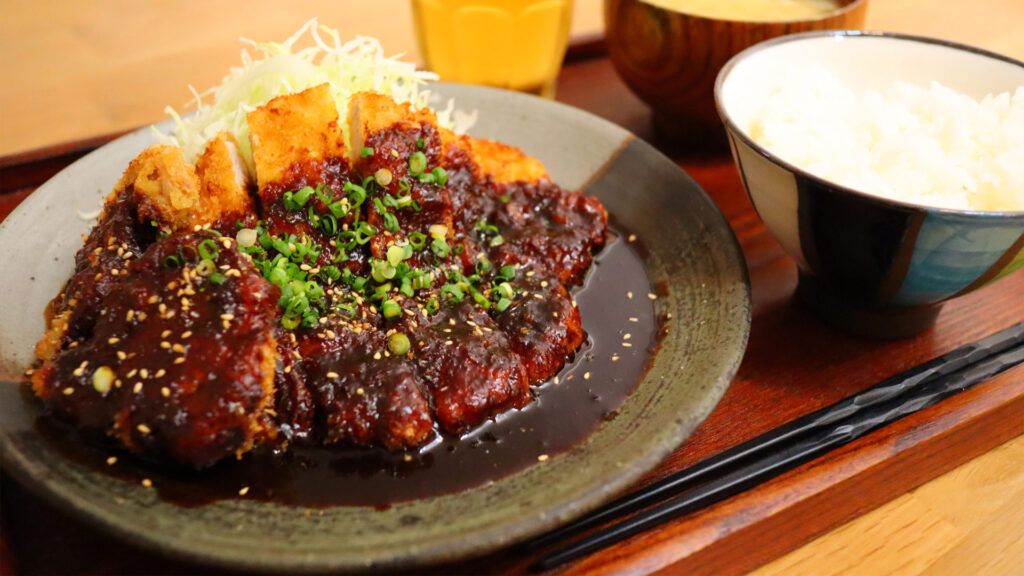
Nagoya is known for its unique cuisine, which stands out from other Japanese regions and is often characterized by bold, rich flavors. Here are some of the most famous culinary specialties you should try when visiting Nagoya:
Miso Katsu
Miso Katsu is a special variation of the classic Japanese dish Tonkatsu (breaded and deep-fried pork cutlet), served with a strong Hatcho miso sauce. Hatcho miso is a dark, thick soybean paste that has a rich, slightly sweet flavor. This specialty is particularly popular in Nagoya and is served in many restaurants.
Hitsumabushi
Hitsumabushi is a dish made with grilled eel (unagi), served on rice. The eel is glazed with a special sweet soy sauce and served in bite-sized pieces on top of the rice. There is a traditional way to enjoy Hitsumabushi: first, eat it as is, then with spices, and finally as “Chazuke” by pouring broth or green tea over it. This dish is especially well-known and beloved in Nagoya.
Tebasaki
Tebasaki are spicy chicken wings fried in a special marinade, which is often slightly sweet and peppery. Unlike Western chicken wings, Tebasaki in Nagoya are usually crispier and made without batter. They are popular as a side dish with beer or sake and are commonly served in Izakayas (Japanese pubs).
Kishimen
Kishimen are flat, wide udon noodles served in a clear broth made with soy sauce, bonito, and kombu (seaweed). They have a soft, almost silky texture and are often garnished with green onions, fish cake (kamaboko), and occasionally tempura. This noodle dish is typical of Nagoya and is available in various versions.
Tenmusu
Tenmusu is a combination of Onigiri (rice balls) and Tempura. It consists of a rice ball filled with a shrimp wrapped in tempura batter and partially wrapped in nori (seaweed). This handy and tasty dish is perfect as a snack and is very popular in Nagoya.
This small selection of culinary specialties makes Nagoya a paradise for food lovers, offering a variety of dishes that reflect both regional traditions and creative reinterpretations of Japanese cuisine.
Arrival and Accommodation in Nagoya
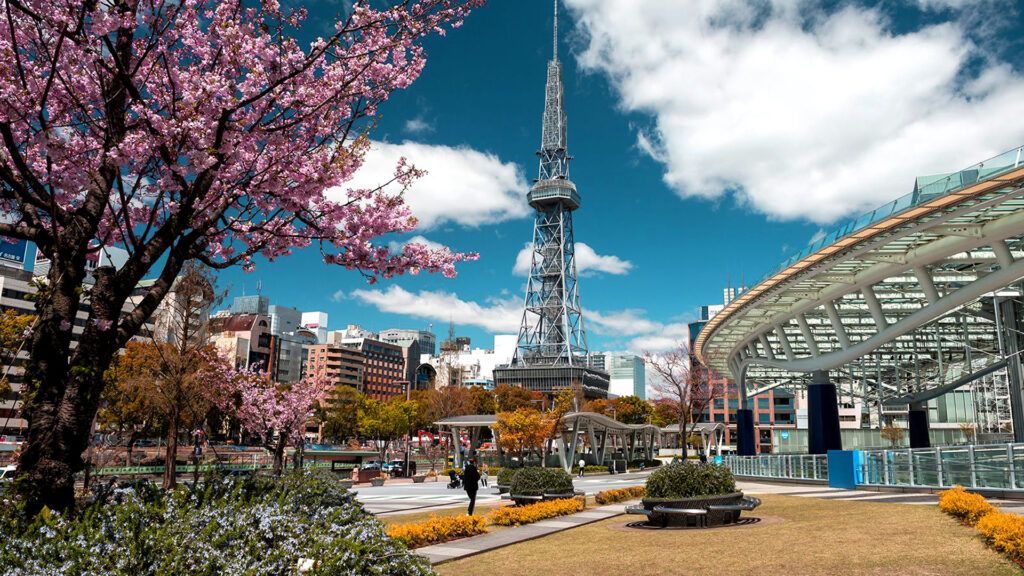
Nagoya is one of Japan’s major metropolises and is easily accessible by train, airplane, or bus. Here are the most common ways to reach the city:
By Shinkansen (High-Speed Train)
The Shinkansen is one of the fastest and most convenient ways to reach Nagoya. The city is located on the Tokaido Shinkansen Line, which connects Tokyo and Osaka. The journey from Tokyo takes about 1 hour and 40 minutes by the Nozomi Shinkansen, about 35 minutes from Kyoto, and around 50 minutes from Osaka. The Shinkansen stops at Nagoya Station, a major transportation hub with connections to the city’s public transport network.
The Nozomi is the fastest train on this line but is not included in the Japan Rail Pass. If you plan to use the pass, you can take the Hikari or Kodama Shinkansen, which take slightly longer.
By Airplane
Nagoya is served by Chubu Centrair International Airport, located about 30 kilometers south of the city on an artificial island in the sea. There are regular flights to destinations throughout Japan and internationally, especially to Asia.
From the airport to the city center: The fastest way to reach the city center is by the Meitetsu Limited Express, which goes directly from the airport to Nagoya Station. The journey takes about 30 minutes. Alternatively, airport buses, taxis, and rental cars are also available.
By Train (Local and Regional Trains)
Nagoya is well-connected to nearby cities and regions by various rail lines:
The Meitetsu Line connects Nagoya to cities in the region such as Inuyama and Gifu and is a popular option for day trips.
The JR Chuo Main Line connects Nagoya to the Kiso region to the west and Nagano Prefecture. The JR Tokaido Line also departs from Nagoya, connecting the city to Kyoto and Shizuoka.
For northern and eastern regions, the Aonami Line is practical, especially for trips to event venues and the harbor area.
By Bus
Long-distance buses provide an affordable alternative to trains, particularly for budget travelers:
Companies like Willer Express and JR Bus operate long-distance bus routes between Nagoya and major cities like Tokyo, Kyoto, and Osaka. The bus ride from Tokyo to Nagoya takes about 5 to 6 hours, and from Osaka about 3 to 4 hours.
Most long-distance buses stop at the Nagoya Station Bus Terminal near the station, making it convenient to continue your journey into the city center.
By Car
Those with an international driver’s license can also travel to Nagoya by rental car. Nagoya is well-connected to the national road network via expressways:
The Tomei Expressway connects Tokyo to Nagoya and runs along the scenic coastline.
The Meishin Expressway connects Kyoto and Osaka directly to Nagoya.
Note that toll fees are charged on Japan’s highways, and traffic in Nagoya can be dense during peak hours. Many central hotels, however, offer parking for guests.
Public Transportation in Nagoya
Once in the city, Nagoya has an extensive subway and bus network, making it easy to get around. The Nagoya Subway consists of several lines that connect the main districts and attractions, including Nagoya Castle, Atsuta Shrine, and the Toyota Commemorative Museum.
Overall, Nagoya is very well connected and easily accessible for both domestic and international travelers.
Nagoya Accommodations
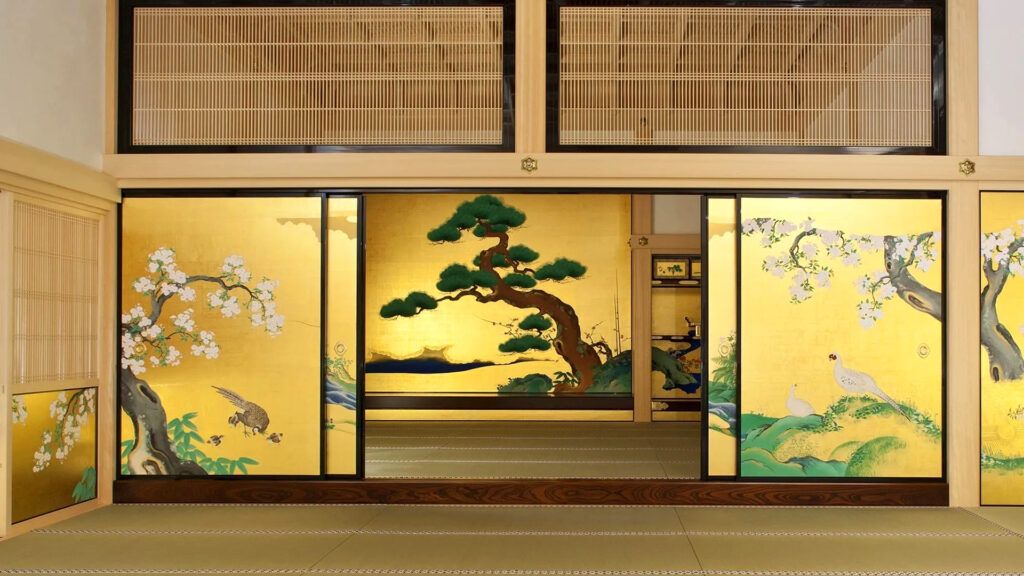
Nagoya offers a wide range of accommodations to suit every taste and budget. From modern hotels to cozy hostels and traditional ryokan, there is something for everyone.
Here are some accommodation recommendations:
Luxury Hotels
Nagoya Marriott Associa Hotel: This 5-star hotel is located directly above Nagoya Station and offers luxurious rooms with impressive views of the city. It is ideal for travelers who value comfort and a central location.
Hilton Nagoya: Centrally located in Nagoya, the Hilton offers elegant rooms, several restaurants, and a wide range of amenities, including a pool, fitness center, and tennis courts.
The Strings Hotel Nagoya: An elegant hotel with modern rooms and excellent service. It is close to the station and offers a spa area and several restaurants.
Mid-Range Hotels
Daiwa Roynet Hotel Nagoya Taiko Dori Side: A modern hotel near the station with comfortable rooms and good amenities. The value for money is excellent here.
Hotel JAL City Nagoya Nishiki: Located in the vibrant Nishiki district, this hotel is ideal for business travelers and tourists. It offers modern rooms and convenient access to shopping and dining options.
Nagoya Tokyu Hotel: Located in Sakae, a popular shopping and entertainment district, this hotel is known for its spacious rooms, friendly staff, and traditional Japanese onsen (hot spring) area.
Ryokan – Traditional Japanese Inns
Kyoya Ryokan: A cozy, traditional ryokan in Nagoya, located in a peaceful area. It offers typical Japanese rooms with tatami mats and futon beds. The ryokan also has a beautiful garden and a public bath.
Ryokan Meiryu: A traditional, affordable ryokan in the heart of Nagoya. The rooms are simply and traditionally furnished, and there is an onsen bath on-site.
Hiratakan: A ryokan located a little outside of the city center in nearby Inuyama. It offers an authentic experience in a peaceful environment, with hot spring baths for relaxation.
Capsule Hotels
Nine Hours Nagoya Station: A modern and stylish capsule hotel near Nagoya Station. It is perfect for an affordable overnight stay and features sleeping pods in a futuristic setting.
First Cabin TKP Nagoya Station: A capsule hotel with airplane-style cabins, offering a slightly more spacious and luxurious capsule experience. The cabins are divided into “First Class” and “Business Class,” ideal for solo travelers.
With this wide selection of accommodations, Nagoya provides numerous options to experience the city comfortably and authentically – whether you prefer luxury or want to enjoy a traditional Japanese atmosphere.
My Personal Conclusion
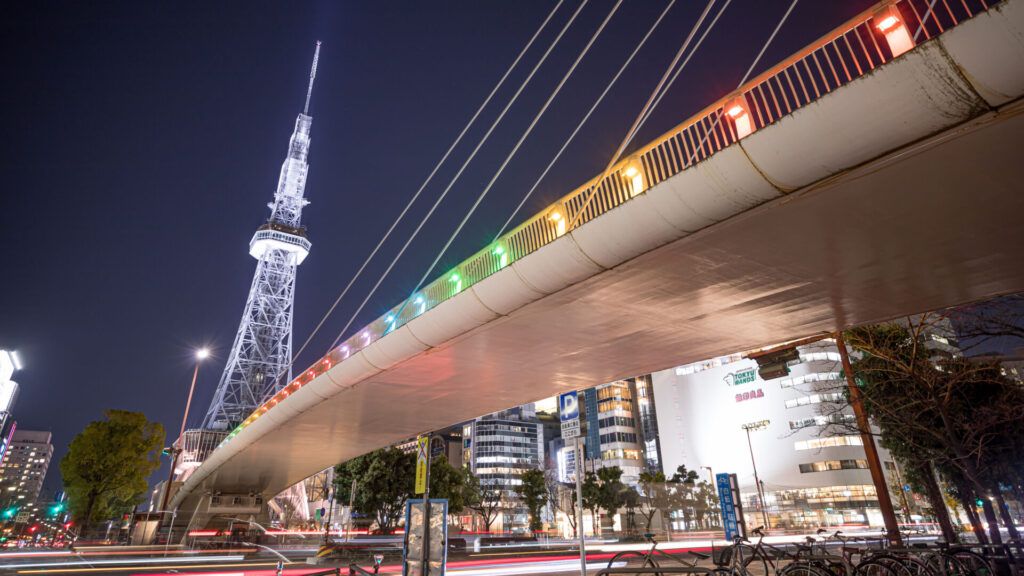
Nagoya may not be the first city that comes to mind when thinking of Japan, but it has a unique charm that fascinated me, and I highly recommend it to everyone. It combines the best of traditional Japan and modern life in a way that is truly unparalleled. Because Nagoya is so modern, it offers the perfect balance between highly developed Japanese urbanity and cultural roots that are deeply embedded in the country’s history.
The city is a vibrant hub for technology and innovation, especially in the automotive industry, which gives it a fresh, dynamic energy. Yet, despite its modern vibe, there are countless small oases of tradition: from the majestic Nagoya Castle, which preserves the history and architecture of the Edo period, to ancient shrines and peaceful tea houses that allow you to step back in time. This blend makes you feel like you’re experiencing Japan from a new perspective.
Culinarily, Nagoya is a treasure trove of unique flavors that can only be found here – the bold tastes of Miso Katsu, the rich Hitsumabushi, or the distinctive Tebasaki chicken wings. The cuisine is an adventure in itself, offering deep insights into the local culture and tastes that are unlike anywhere else.
For me, Nagoya was more than just a stopover. The city offers an authentic and less touristy glimpse of Japan, showing how tradition and modernity can harmoniously blend. Whether strolling through the bustling streets of Sakae, admiring the majestic towers of Nagoya Castle, or experiencing the city’s hospitality in a traditional ryokan, Nagoya is worth the visit because it perfectly embodies the versatility of Japan.


